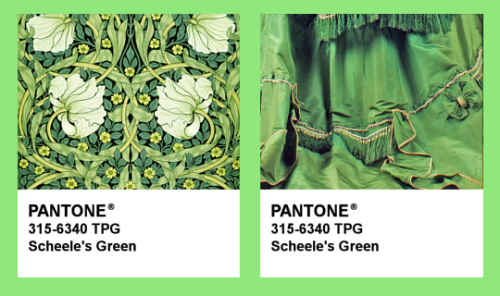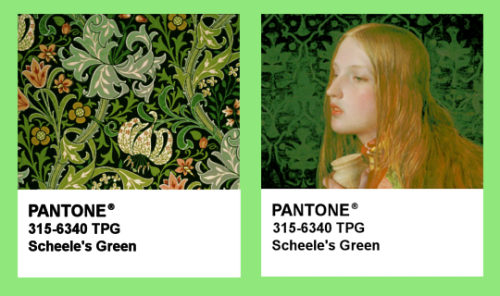HISTORY IN COLORScheele’s GreenRGB: (71, 136, 0) Closest Pantone match: 315-6340 TPG Inven
HISTORY IN COLORScheele’s GreenRGB: (71, 136, 0) Closest Pantone match: 315-6340 TPG Invented in 1775 by chemist Carl Wilhelm Scheele, Scheele’s Green is an artificial pigment synthesized from sodium carbonate, arsenious oxide, and copper sulfate. It reached the peak of its popularity around the mid-19th century, when the discovery of various artificial dyes made bright colors in clothing and décor both desirable and available to a wider public. The durability and brilliancy of Scheele’s Green compared to the previously-used copper carbonate pigments made it a popular choice for tinting wallpaper, fabric, candles, children’s toys, and even sweets. However, due to its arsenic base, Scheele’s Green proved to be highly poisonous. Products dyed with it would release toxic acid, dust or gas when exposed to conditions such as heat, damp or mold. Direct contact with the dye would slowly poison those who worked with it, causing open sores, yellowed nails and a greenish tint to the skin. Among the last things nineteen-year-old false flower maker Matilda Scheurer could tell her doctor in a widely publicized account was that “everything she looked at was green”. Meanwhile, pre-Raphaelite artist and wallpaper designer William Morris insisted that miners suffering from arsenic poisoning were simply “bitten by witch fever”. The color began to fall out of favor as the gruesome accounts of death and illness piled up. By the end of the 19th century, arsenic-based dyes were replaced by the safer cobalt green. A motion was drafted in Britain to outlaw the use of arsenic to dye household products, but it was never passed. -- source link
Tumblr Blog : codexgrolier.tumblr.com
#historyedit#scheeles green#william morris#pantone#pantone edit#arsenic#my edit


